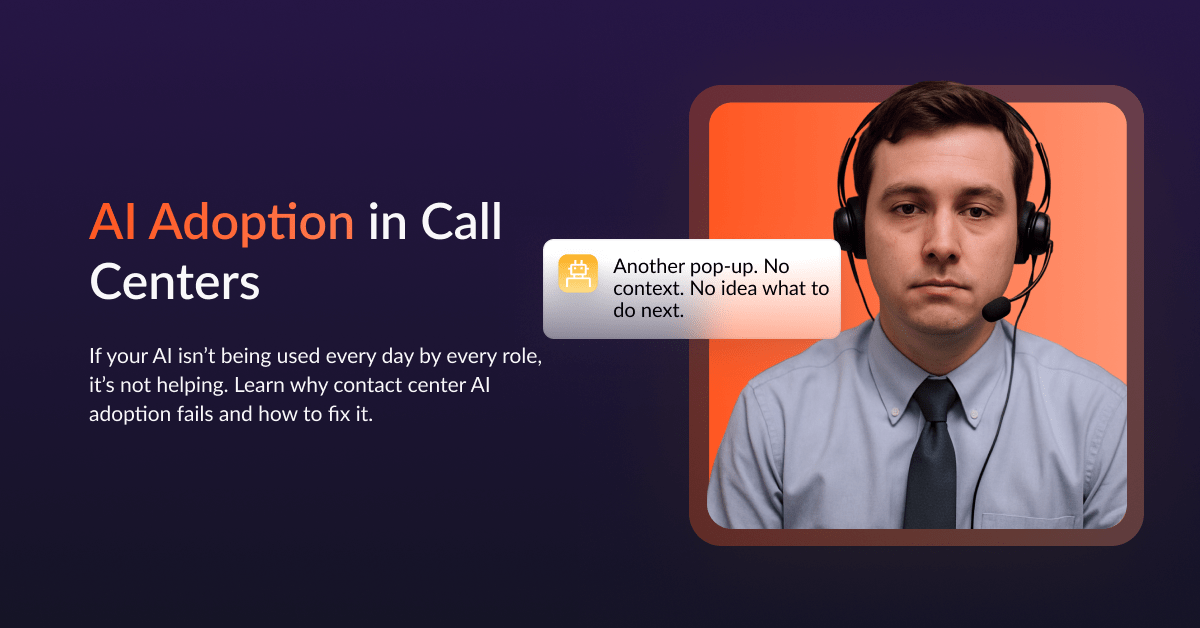AI Adoption in Call Centers: Why Platforms Sit on Shelves (and Why AmplifAI Doesn’t)

Leaders invest in contact center AI to improve performance, but many platforms end up underused. A few teams may log in, and the dashboards might look impressive, but behavior doesn’t change. Coaching impact remains unclear, KPIs stay flat, and no one can explain why the tool is not delivering value.
This is the outcome most AI vendors avoid discussing, the implementation team deflects, and operations leaders hesitate to take responsibility for. The blame for lack of employee adoption inevitably falls on user resistance, training gaps, or the AI itself. But the problem is not change management, or AI technology in general, the problem is data.
Most contact center AI platforms are not connected to the call center data they need to be useful.
The difference in adoption rates is clear in everyday ‘useful’ tools. No one had to run an adoption campaign for GPT or co-pilot apps. People use them because they’re helpful, immediate, and relevant to their work.
The experience of these AI tools is built around real needs and live context. Without real-time, unified data, AI cannot surface accurate insights or recommend meaningful actions, and if it can’t drive action, it doesn't get used.
When insights are delayed, incomplete, or disconnected from daily workflows, adoption fails because the system doesn't deliver value when, where, and with who needs it.
In most operations, AI implementations are not unified, they’re siloed.
- CX leaders have insight platforms tied to their own GPTs
- QA teams use standalone auto-QA and compliance tools
- Team Leaders rely on performance dashboards disconnected from quality or coaching
- Agents toggle between real-time assist tools, co-pilots, and scattered knowledge bases
Each role gets a sliver of AI. Each tool sees a sliver of data, and none of it works together.
This is not an AI platform. It is an AI patchwork.
Instead of addressing these structural gaps, most AI vendors lean on out-of-the-box data integrations as a shortcut, introducing long-term limitations locking teams into systems that cannot evolve with the business.
What ‘Out-of-the-Box’ Data Integration Really Means
Out-of-the-box integrations sound like a nice easy shortcut. Quick to launch, easy to use, and pre-integrated with your systems.
But you know how it works in reality.
Everything’s going smooth until you hit that one custom data point, a critical KPI that doesn’t fit the default template and suddenly, that “easy” integration becomes a backlog ticket. Now you’re paying more for something that does less than you expected or worse, the deployment gets stalled, underperforms, and becomes another cost leak that gets replaced 18 months later.
Best case scenario? The tool still goes live, but it’s not connected to your full context, and that means it’s not connected to real performance, with the same outcome on the next buying cycle.
In contact centers, there is no such thing as one-size-fits-all. Every organization runs on a mix of systems, workflows, and priorities that evolve constantly.
No out-of-the-box setup can account for that. So when contact center AI is layered on top of mismatched data, brittle integrations, and generic workflows adoption doesn’t just stall, it breaks.
This is how contact center AI platforms become 'shelfware'.
They launch with energy and expectation, but without integrated call center data or relevance to daily work, teams will disengage.
The AI platform stops being used because it is not connected to the actions that drive performance.
Why Most AI Fails to Drive Action
Let’s say you’ve made it through integration, the tool is live, data’s flowing (mostly), and dashboards are up.
Now comes the real test, is anyone using it to actually improve performance?
Most contact center AI platforms:
- Generate insights but not momentum.
- Show trends but don’t tell you what to do next.
- Surface data but not decisions.
Without clear, relevant, role-specific actions adoption stalls again, because in a high-velocity environment like the contact center, no one has time to interpret vague metrics or dig through static dashboards hoping for a coaching moment.
- Agents need to know:
How am I doing right now? What should I do differently on the next call? - Team Leaders need to know:
Who needs coaching today? On what behaviors? - QA teams need to know:
Which interactions actually need human review? Is performance improving because of what we’re flagging or in spite of it? - CX leaders need to know:
What’s changing at scale and how do we shift it faster? - Executives need to know:
Is our AI investment driving measurable outcomes in retention, NPS, revenue, and efficiency? - Vendor managers in BPO environments need to know:
Which partners are improving, which are lagging, and how do we drive consistency across multiple vendors and geos without another tool just for that?
If your AI platform can’t deliver that in real time, in context, for every role, it’s not driving action. Once teams realize they have to leave the platform to figure out what to actually do, they stop using it.
What Drives True AI Adoption (And Why It Rarely Happens)
AI doesn’t get adopted because it’s flashy or smart. It gets adopted because it’s useful to every role, every day.
That only happens when three conditions are met:
1. The Data Is Unified and Alive
If your data’s fragmented or delayed, your AI will be too.
Real AI adoption starts with a continuously updating layer of performance data, not just a snapshot from last night’s sync.
When AI can see what’s happening as it happens, it can intelligently support decisions in real time.
That means:
- No waiting for next-day dashboards
- No blind spots between systems
- No lag between performance and response
This kind of intelligence can’t be built on brittle connectors or batch files. It has to live and breathe with the contact center.
2. The Insights Are Role-Specific (and Immediately Actionable)
Adoption fails when AI feels abstract. Agents, coaches, QA, CX, and ops each need different actions, not just different views. Surface-level personalization doesn’t cut it.
What drives AI tool adoption is relevance. Not “here’s a dashboard,” but instead “here’s what to do next.”
You don’t get that kind of relevance from disconnected data. If your systems aren’t talking to each other, your AI isn’t saying much either.
3. The AI Fits the Way You Work
AI shouldn’t ask your team to reinvent how they operate. It should plug into your rhythm through daily standups, weekly coaching, live floor support, ops reviews, and make each one sharper. That’s what turns AI from a tool into a habit.
It doesn’t matter how impressive the AI is if the outputs live in a system no one checks, at a time no one needs, in a format no one understands.
When these three conditions are met:
- Living data,
- Role-specific actions, and
- Operational alignment
The result isn’t theoretical. It's an operational and intelligent AI.
This is the structure AmplifAI was built on. AmplifAI contact center AI connects directly to the systems that matter including calls, voice/speech analytics, QA events, CRM activity, surveys, flat files, power BI systems, behavioral metrics, and continuously unifies those inputs into a single, real-time, AI-ready foundation.
AmplifAI's foundation of full data unification powers performance insights, QA workflows, next best actions (role specific), AI agents, and real-time executive-level dashboards that deliver relevance and alignment across roles from frontline agents to team leaders, QA, BPO managers, CX owners, and senior leadership.
How to Know If Your AI Platform Is Being Adopted
Employee AI adoption isn’t measured in logins or implementation milestones. It’s measured in daily usage and cultural embedding, the things that actually move performance.
If you want to know whether your AI platform is actually helping or quietly becoming shelfware, start here:
The biggest sign of AI tool adoption?
You don’t have to ask whether it’s being used. It’s already how the team works.
What to Ask Before Choosing an AI Platform
If you want contact center AI that gets used and stays used, don’t just ask about features. Ask how the platform fits your operation, your data, and your people.
Here’s what to press on:
Want a deeper look at how to evaluate vendors?
Get the full breakdown in our Contact Center AI Buyers Guide.
Final Word: Employee Adoption Is the ROI Multiplier
Contact center AI that doesn’t get adopted doesn’t just waste money, it delays progress. It wastes cycles, erodes trust, and forces teams to work around the very system that was supposed to help them.
Here’s the part most AI vendors won’t tell you:
Employee adoption isn’t a UX problem. It’s a data problem.
Most contact center AI vendors don’t want to do the messy work of unifying data to make their tools operationally capable.
You can’t drive consistent action when every team is working from different tools, disconnected metrics, and outdated snapshots. Adoption only becomes second nature when the AI is powered by a single, live foundation that updates in real time, connects across roles, and reflects what’s really happening on the floor.
The contact center AI platforms that achieve the highest adoption aren’t the ones with the most features or the flashiest dashboards. They’re the ones that actually get used because they’re built for real people, connected to real data, and embedded into the daily rhythm of work.
That’s why AmplifAI has the highest employee adoption rates in the contact center AI space.
Every role finds value. Every insight is grounded in reality. Every action connects back to what drives performance.
Employee adoption isn’t just a sign of success. It’s what makes success possible.
See why AmplifAI call center AI software has the highest employee adoption rates in the industry.
"Lorem ipsum dolor sit amet, consectetur adipiscing elit. Etiam eu leo ut leo ullamcorper sodales et vitae felis."
💡 Your heading here
Lorem ipsum dolor sit amet, consectetur adipiscing elit. Etiam eu leo ut leo ullamcorper sodales et vitae felis. Maecenas ante libero, pretium et risus nec, iaculis elementum libero.
📝 Your heading here
Lorem ipsum dolor sit amet, consectetur adipiscing elit. Etiam eu leo ut leo ullamcorper sodales et vitae felis. Maecenas ante libero, pretium et risus nec, iaculis elementum libero.
⚠️ Your heading here
Lorem ipsum dolor sit amet, consectetur adipiscing elit. Etiam eu leo ut leo ullamcorper sodales et vitae felis. Maecenas ante libero, pretium et risus nec, iaculis elementum libero.
✓ Your heading here
Lorem ipsum dolor sit amet, consectetur adipiscing elit. Etiam eu leo ut leo ullamcorper sodales et vitae felis. Maecenas ante libero, pretium et risus nec, iaculis elementum libero.
Your heading here
Lorem ipsum dolor sit amet, consectetur adipiscing elit. Etiam eu leo ut leo ullamcorper sodales et vitae felis. Maecenas ante libero, pretium et risus nec, iaculis elementum libero.
Ready to take your CX teams to the next level?
Save Time & Download The Bundle!
30 minutes today can extend your contact center capacity by 30%.
We've published all 8 Coaching Guides into one amazing package.
Get your free copy now!






.png)





